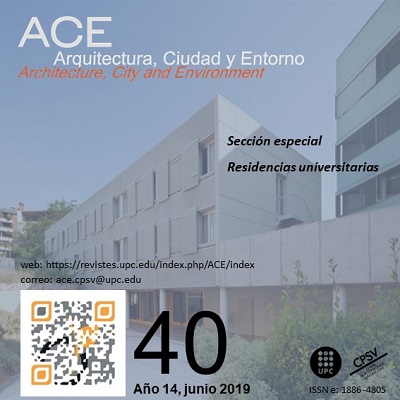Van Der Laan i Messiaen, la llibertat creativa d'un sistema
DOI:
https://doi.org/10.5821/ace.14.40.5374Paraules clau:
Composició arquitectònica, Teoria musical, raó matemàticaResum
Objectius
Un nombre creixent d'expressions artístiques a tot el món donen la impressió que la creació té una arrel sistemàtica basada en la definició dels elements i la seva interrelació. L'objectiu d'aquest estudi és investigar la naturalesa d'aquests sistemes, tant en arquitectura com en música, i emfatitzar que la llibertat del creador no es veu disminuïda pel seu ús.
Metodologia
Dos autors ben coneguts, l'arquitecte Dom Hans van der Laan i el compositor Olivier Messiaen, s'analitzen a través dels seus propis sistemes de treball i el terme "necessitat universal" s'utilitza per definir els seus problemes de treball resolts mitjançant mètodes matemàtics.
Resultats
Els resultats mostren que es pot aconseguir la llibertat creativa des de l'ordre, i indica que conèixer les regles del sistema de la disciplina és una forma d'aconseguir la llibertat creativa.
Originalitat
Hi ha una controvèrsia sense resoldre durant segles en la discussió de la creativitat i l'estètica centrada en la pregunta: ¿Un conjunt de regles, com les regles de contrapunt, estimulen o inhibeixen l'expressió dels artistes? Aquest document vol contribuir a aquest debat afegint dos exemples que són independents, però també relacionats. Aquesta investigació està dirigida a acadèmics, historiadors de l'art i l'arquitectura i acadèmics en ambdues disciplines, arquitectura i música.
Descàrregues
Publicades
Número
Secció
Llicència
| CRITERIS DE PROTECCIÓ INTEL·LECTUAL |
En aquest moment es compta amb la protecció de la Oficina Espanyola de Patents i Marques, mentre que la protecció global s'està tramitant davant la Organització Mundial de la Propietat Intel·lectual (OMPI/WIPO). Així mateix, la Oficina del Número de Sèrie Estàndar Internacional (ISSN) ha otorgat els següents números: 1886-4805 (versió electrònica) i 1887-7052 (versió en paper). |
| COPYRIGHT |
El contingut dels articles i els comentaris en ells expresats són responsabilitat exclusiva dels seus actors, i no reflexen necessariament la opinió del Comité Editor de la revista. Els treballs publicats per ACE queden sotmesos a la llicència CC BY-NC-ND 3.0 ES http://creativecommons.org/licenses/by-nc-nd/3.0/es/ La qual cosa vol dir que les persones autores només tenen i retenen els drets d'autor dintre de les limitacions imposades per la anterior llicència |





































